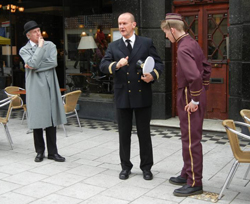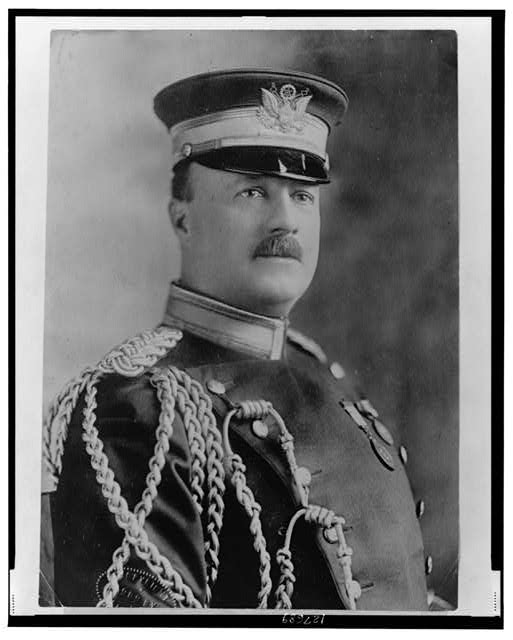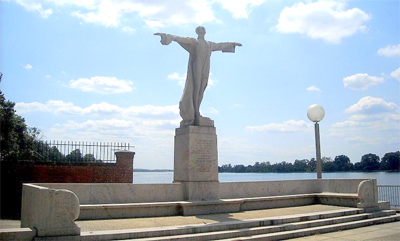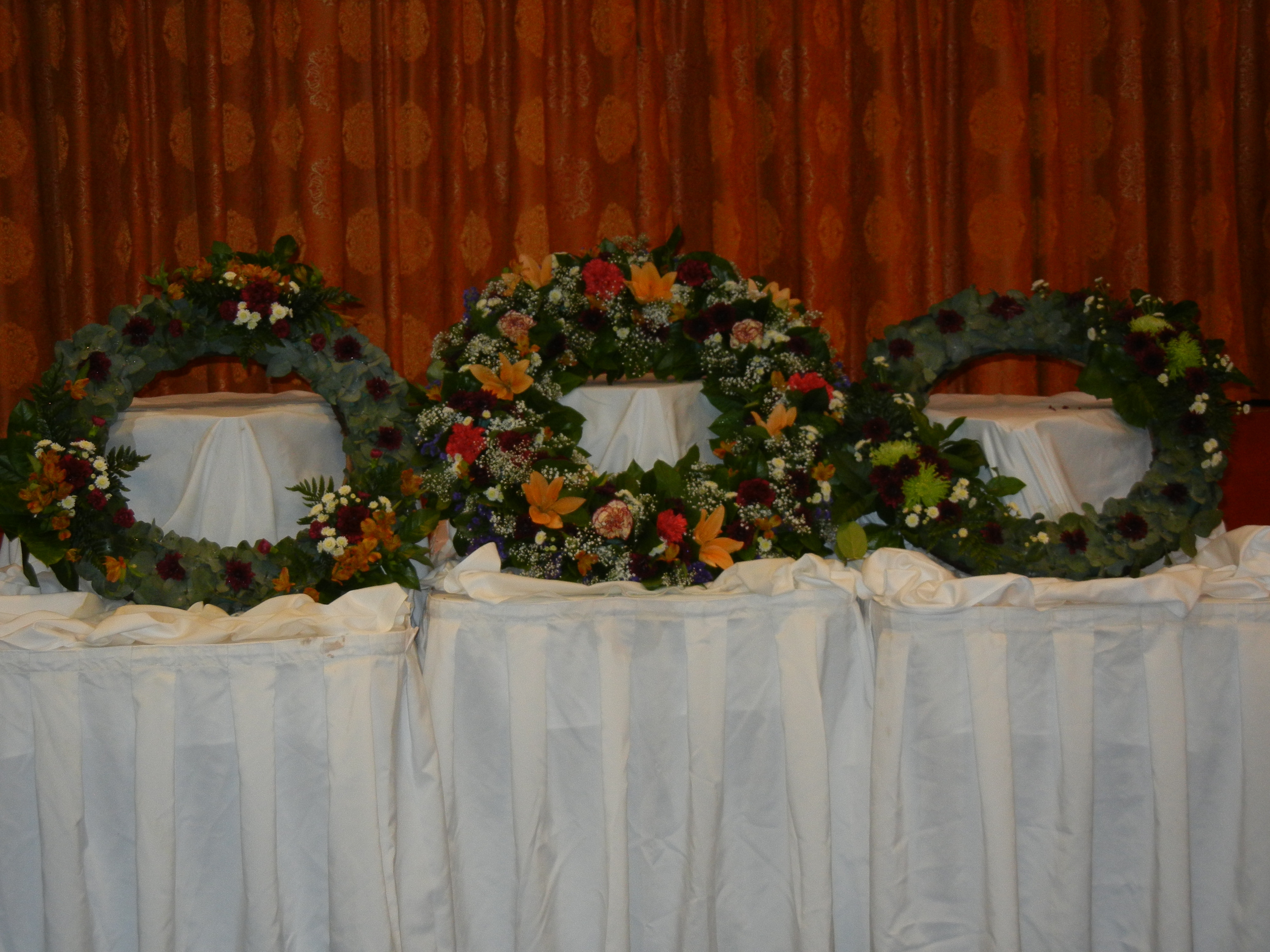In April of 1912, Washington, D.C. officials and First Lady Helen Taft were busy beautifying the city with cherry trees while President William Howard Taft was looking forward to the return of his military advisor, Major Archibald Butt. Major Butt had finished a tour of Europe and had booked his trip home on the grandest luxury liner of the day, the RMS Titanic. The ship set sail from Southampton, England with Major Butt aboard. Titanic picked up passengers including Butt's close friend Francis "Frank" Millet in Cherbourg, France, then stopped in Cobh, Ireland before turning toward the United States.
Titanic was carrying 2,208 passengers and crew, including wealthy aristocrats and emigrants embarking for a new life in the United States, when she struck an iceberg in the North Atlantic. The ship sank in less than three hours, taking 1,516 people, including Butt and Millet down with her. This tragedy shook the world.
One hundred years later, as visitors from around the world were coming to Washington, D.C. to view the beautiful cherry blossoms on their centennial year, I and another park ranger, Kathy Kagle, boarded the Balmoral for the cruise of a lifetime - the Titanic Commemorative Cruise. Twenty-seven countries were represented by passengers on the ship, from Titanic enthusiasts down to the mildly interested traveler. Kathy and I fell somewhere in the middle.
We boarded the Balmoral in Southampton, England within 50 yards from the original dock that the Titanic had occupied. The first thing we were required to do was to go through an emergency drill in which everyone had to find and put on their life jackets, then report to a station, depending upon which deck and room number they had. Once we were all gathered at our specific stations, we were told which crew member to report to, which lifeboat was ours, where it was located, and how to get to it quickly. Every cruise ship today goes through this drill because of the Titanic. "Regulations for Safety of Life At Sea" was adopted in 1914 in response to the Titanic tragedy. The regulations required improvements in communications among ships, ensured enough lifeboats for all passengers and crew, and provided training in emergency procedures for all crew members.
Before the Balmoral left port, we had some free time to take an excursion through the medieval town of Southampton. Through living history demonstrations by the locals, we experienced another side of the tragic story of Titanic. Southampton was suffering from an economic depression in 1912. When the White Star Line established an office in the town, it brought the promise of much-needed employment to staff the company's newest ship, Titanic. Out of Titanic's crew of around 900, 549 came from Southampton. When the ship went down, nearly every family in this town lost a family member. The White Star Line refused to return bodies recovered from the surface unless the families paid £20, the equivalent of a year's wages. Along with the town's grief, this lack of compassion from White Star brought such bitter resentment that very few spoke of the Titanic for years.

Living history demonstration in Cobh, Ireland
The Balmoral coming to Southampton was like a shadow of the Titanic haunting the town. Everyone knew what this ship represented. Many came to the dock to look upon it and to welcome us. With passengers coming up and down the ship's ramp dressed in 1912 period clothing, this scene was the closest that the town's current population had ever come to witnessing what it might have been like when the Titanic first set sail there. It was a bittersweet experience because Balmoral raised memories of a past the town wanted to forget, but could not. Our passenger list included descendants of Titanic's crew and passengers that died when the ship went down. Because their families had been torn by this disaster, they felt it was important for them to sail on the Balmoral to the watery gravesite of the grand ship, and to Halifax, Nova Scotia, where the White Star Line company buried their ancestors. But most important, they desired to set foot in New York City and complete the journey that their ancestors were not able to. For many of them, this voyage would bring closure for them as well as their families.
There were several passengers on board the Balmoral who felt that we were tempting fate following the original, disastrous path of the Titanic. When we left Cobh, Ireland, the last port where the Titanic picked up passengers, we ran into rough seas with winds up to 40 miles an hour. The Balmoral rocked and bounced for days on its way to the Titanic's gravesite. Several people became seasick and a crew member developed a serious medical condition and had to be evacuated by helicopter back to Cobh. The ship had to turn around and meet the helicopter halfway. There was always the thought that perhaps we were destined for a disaster too. As we finally were heading toward the North Atlantic gravesite, the seas calmed down and the Balmoral sailed on to be at the site by Saturday, April 14.
The evening of the 14th was a solemn occasion. This was the night of the memorial service and the centennial of the sinking of the Titanic. At 11:40 p.m. the ship's whistle sounded and everyone stopped and stood for a moment of silence. This was the exact time that the Titanic had struck the iceberg. At midnight we gathered into the main restaurant for the service conducted by The Reverend Canon Huw Mosford, Director of Chaplaincy, Mission to Seafarers. Three wreaths were blessed and three candles were lit, each by a descendant of someone lost that night one hundred years ago. Then all 1,860 passengers and crew filed quietly out to the stern of the ship. Flying silently off the back of the Balmoral was the White Star flag. It struck me that this was probably the last time the White Star flag will ever fly on a ship again. There was not a sound made as people viewed the North Atlantic water beneath, which the Titanic, broken and mangled, lay two and a half miles down on the ocean floor. Crew members threw the wreaths into the icy, black water. The service was concluded with Anthony Stuart Lloyd singing, 'Nearer My God to Thee.' The ocean was calm and the sky was full of stars, exactly as it was that fateful night. The service ended at 2:20 a.m. on April 15th, the exact time and date the Titanic sank below the surface one hundred years before.
Wreaths onboard the Balmoral
Although the Titanic sank in the North Atlantic, the tragedy did have a direct impact on Washington, D.C. There was a major investigation into the wreck just twelve hours after the Carpathia brought the Titanic survivors to New York. Senator William Alden Smith of Michigan convened a Senate inquiry into the disaster that started at the Waldorf-Astoria Hotel in New York City, and then moved to the new Russell Senate Office Building in Washington, where the surviving officers and crew of the Titanic had to testify. The inquiry became a blame game of sorts, and the Titanic's captain, the late Edward John Smith, received the brunt of the accusations. Smith was later blamed for the tragedy.
Many Washington notables were traveling first-class on board the Titanic. Helen Churchill Candee, an author and trustee of the Corcoran Gallery, was coming home to be with her son who had been in a car accident. She escaped in lifeboat #6, alongside Margaret "Molly" Brown, and later wrote a fictional account based on her experience. Clarence Moore, a prominent businessman and financier, was together with friends Archibald Butt and Frank Millet when the Titanic struck the iceberg, and all three died tragically. Archibald Butt was a friend and military advisor of former president Theodore Roosevelt and President William Taft. Butt's body was never found. Millet's body was recovered by the MacKay-Bennett and sent to Massachusetts for burial. Today, the Butt-Millet Memorial fountain, located on the Ellipse in President's Park, honors the memory of Archibald Butt and Frank Millet.

Archibald Butt
(Library of Congress)
Before he died on the Titanic, Frank Millet had a direct impact on the design of the National Mall. He was a world renowned artist and vice chairman of the U. S. Commission of Fine Arts. When Congress debated the placement the proposed Lincoln Memorial, Millet recommended its current location in West Potomac Park. Because of Millet, the Lincoln statue looks straight down the National Mall toward the statue of General Ulysses S. Grant. Grant, symbolically still protecting the Capitol, is looking back at Lincoln, his Commander-in-Chief.
With the support of Helen Taft, the Titanic Memorial was dedicated in Washington, D.C. on May 26, 1931. The memorial honors the men on the Titanic who gave their lives so that women and children might be saved. Originally located on the current site of the Kennedy Center, the Titanic Memorial is now located on 4th and P Streets, SW. Titanic memorials are located around the world in cities including New York, Southampton, Cobh, and Belfast.

Titanic Memorial, Washington, D.C.
While on the Balmoral's history-making voyage, Kathy and I often walked down the ship's main corridor, reading banners with biographies of individuals that sailed on the Titanic. Seeing the pictures and biographies of people on the ship, especially those from Washington, made the experience more relevant and special to us. The memory of those who lost their lives on the Titanic persists in the Butt-Millet Memorial and the Titanic Memorial in downtown Washington. Our memories of the anniversary cruise will live in the stories that we share with visitors to the National Mall.

